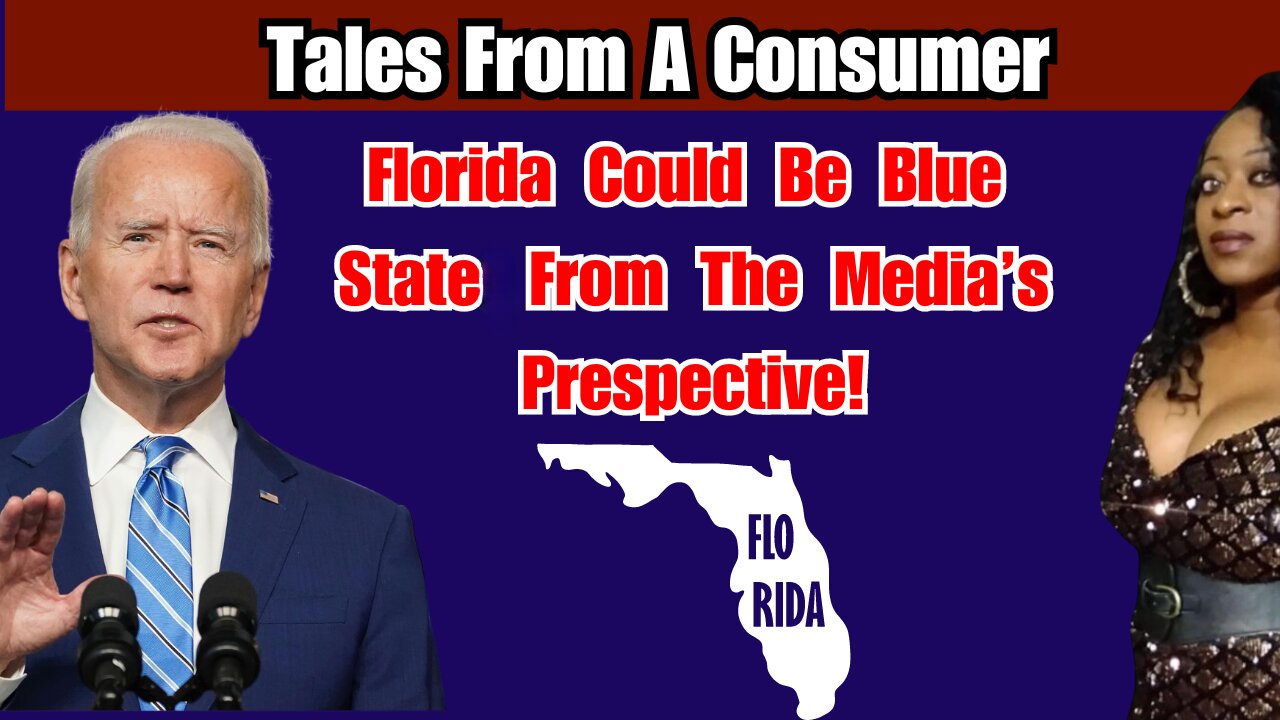Premium Only Content

Florida Could Become A Blue State According To The Media😲
As the 2024 elections approach, Florida's political landscape is under intense scrutiny. Once a reliably red state, there is growing speculation that Florida could shift to blue this year. The prospect is intriguing and significant, given Florida's status as a swing state with a substantial number of electoral votes. To understand this potential shift, it's essential to examine the factors at play from a neutral standpoint.
Media Predictions and Reality
Historically, media predictions about election outcomes have varied in accuracy. While polls and expert analyses often provide insights, the actual results sometimes diverge from expectations. For Trump supporters, the current media narrative suggesting a potential blue shift in Florida is concerning. However, understanding the underlying reasons for this speculation can help mitigate fears and provide a clearer picture of the political dynamics.
DeSantis's Waning Popularity
Governor Ron DeSantis, once a highly favorable figure within the Republican Party, has seen his popularity fluctuate. Initially, his strong stance on various conservative issues bolstered his reputation. However, recent actions and policies have alienated some supporters. DeSantis's handling of the COVID-19 pandemic, his controversial stances on social issues, and his confrontations with state officials have contributed to a decline in support.
DeSantis's clashes with the state's Attorney General and other officials, perceived as targeting minorities and those who disagree with him, have sparked significant backlash. For instance, his decision to remove certain officials from their positions due to disagreements over policy implementation has been controversial. These actions have not only divided the Republican base but have also mobilized opposition among independents and moderate conservatives.
Trump's Impact on the GOP Base
Former President Donald Trump's influence on the Republican Party remains substantial, but it is not without complications. Trump's rhetoric and policies have polarized the electorate, including his base. Some of his actions and statements have alienated segments of his once-faithful supporters. This division is particularly evident among minorities, the LGBTQ+ community, and other groups who feel marginalized by his policies.
One notable example is Trump's stance on immigration, which has been a double-edged sword. While it has solidified support among some conservatives, it has also driven away others who view his approach as too extreme. Additionally, Trump's handling of racial issues and his responses to protests and social movements have further complicated his relationship with minority voters.
Demographic Shifts and Changing Attitudes
Florida's demographic landscape is changing. The state has seen an influx of younger, more diverse populations who tend to lean Democratic. The growth of Hispanic, African American, and immigrant communities has the potential to shift the political balance. These groups have increasingly voiced their dissatisfaction with Republican policies, particularly those perceived as discriminatory or exclusionary.
Furthermore, the changing attitudes among suburban voters, who are becoming more concerned with issues like climate change, healthcare, and education, are influencing Florida's political dynamics. The Republican Party's stance on these issues, often seen as out of touch with the priorities of these voters, could be driving them towards the Democratic Party.
Conspiracy Theories and Political Narratives
Conspiracy theories and political narratives also play a role in shaping voter perceptions. Among some conservative circles, there is a belief that the media and political elites are manipulating information to undermine the Republican Party. These theories suggest that polls predicting a blue shift in Florida are part of a broader effort to demoralize Trump supporters and suppress voter turnout.
On the other hand, there are conspiracy theories within liberal circles that argue the Republican Party is actively working to disenfranchise minority voters through gerrymandering and voter suppression tactics. These narratives fuel distrust and motivate voters to turn out in greater numbers to counter perceived injustices.
Poll Data and Trends
Poll data provides some empirical basis for the speculation about Florida's potential shift. Recent polls show a narrowing gap between Republican and Democratic candidates, with some even giving a slight edge to the Democrats. For instance, a recent Quinnipiac University poll indicated that Democratic candidates are gaining ground among key demographic groups, including suburban women and younger voters.
Additionally, voter registration trends show an increase in Democratic registrations, particularly in urban and suburban areas. This shift in voter demographics is crucial in a state where elections are often decided by narrow margins.
The Role of Grassroots Movements
Grassroots movements and community organizations have also played a significant role in mobilizing voters. Organizations focused on voter registration, education, and turnout have been particularly active in minority communities. These efforts aim to counteract voter suppression and ensure that every eligible voter has the opportunity to participate in the electoral process.
For example, groups like the Florida Rights Restoration Coalition have worked tirelessly to restore voting rights to formerly incarcerated individuals, significantly expanding the electorate. Similarly, organizations focused on Latino voter engagement have made substantial inroads in communities that were previously underrepresented in the voting population.
Conclusion
The potential shift of Florida from a red to a blue state is the result of a complex interplay of factors. Governor Ron DeSantis's controversial policies, Trump's divisive influence, demographic changes, and the efforts of grassroots movements all contribute to the evolving political landscape. While media predictions may not always align with election outcomes, understanding these dynamics provides valuable insights into the potential for change. For Trump supporters, this analysis offers a comprehensive view of the challenges and opportunities ahead. For Democrats, it highlights the progress made and the work still needed to secure a victory in a pivotal swing state.
-
 10:19
10:19
Tales From A Consumer
2 months agoBeyonce Instagram Got People BOTHERD!!!!!
1928 -
 LIVE
LIVE
The StoneZONE with Roger Stone
14 minutes agoLBJ + CIA + Mob + Texas Oil = JFK Murder | The StoneZONE w/ Roger Stone
578 watching -
 58:00
58:00
Donald Trump Jr.
7 hours agoBreaking News on Deadly Plane Crash, Plus Hearing on the Hill, Live with Rep Cory Mills & Sen Marsha Blackburn | TRIGGERED Ep.212
107K73 -
 52:03
52:03
Kimberly Guilfoyle
6 hours agoLatest Updates on Deadly Air Collision, Plus Major Hearings on Capitol Hill,Live with Marc Beckman & Steve Friend | Ep.192
60.8K25 -
 LIVE
LIVE
Josh Pate's College Football Show
4 hours agoMichigan vs NCAA | ESPN’s ACC Deal | Season Grades: UGA & Miami | Notre Dame Losses
198 watching -
 1:26:50
1:26:50
Redacted News
4 hours agoWhat happened? Trump DESTROYS the Pete Buttigieg run FAA for tragic airline crash | Redacted News
176K121 -
 43:37
43:37
Candace Show Podcast
4 hours agoThe Taylor Swift Plot Thickens | Candace Ep 142
101K91 -
 LIVE
LIVE
Common Threads
2 hours agoLIVE DEBATE: Trump's Wild Handling of Plane Tragedy
209 watching -
 54:45
54:45
LFA TV
9 hours agoConfirmation Chaos | TRUMPET DAILY 1.30.25 7pm
14.7K1 -
 1:57:53
1:57:53
Revenge of the Cis
5 hours agoEpisode 1437: Kash Me Outside
52.1K15